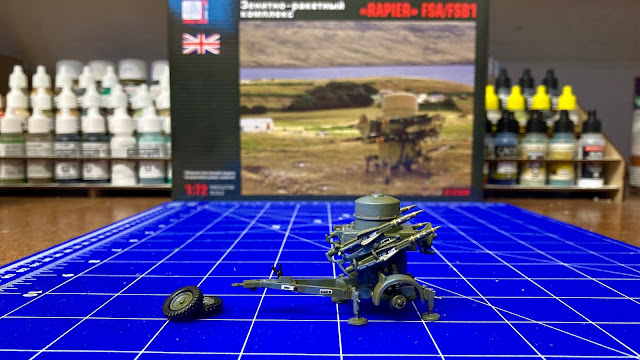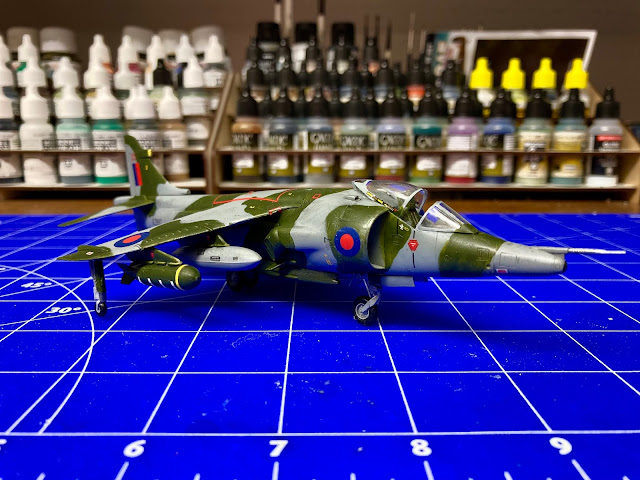Victory in the Falklands is now on a knife edge.
It's 21st May 1982 and the British amphibious forces have landed on the beach at San Carlos. The race is now on to deploy a 'mystical' air defence system. The Navy, Marines and Paras want this deployed within the first few hours of landing. The system is the Rapier.
Without this, it is feared that the landing ships in San Carlos Bay will be sunk by waves of Argentine bombers before they can unload their men and supplies, and the troops on the beach will be forced back into the sea.
The Rapier was a British surface-to-air missile developed for the British Army and RAF Regiment to replace their Bofors 40/L70 anti-aircraft guns. The original Rapier, as deployed in the Falklands War, took the form of a wheeled launcher with four missiles, an optical tracker unit, a petrol powered generator and trailer of stores. The launcher consists of a large cylindrical unit carrying two missiles on each side, the surveillance radar dish and "Identification Friend or Foe" (IFF) system under a radome on top, the guidance computer and radar electronics at the bottom, and a prominent parabolic antenna for sending guidance commands to the missiles on the front. T Battery of the 12th Regiment Royal Artillery from Kirton in Lindsey joined 3 Commando Brigade as part of the Falklands Task Force, landing at San Carlos on 21 May, with additional support from 63 Squadron RAF Regiment from Gütersloh, Germany.

While there had been discussions on opening a second bridgehead following 21 May landings at San Carlos, it was conceded that there were insufficient Rapier launchers available to give effective protection to a second anchorage. As it was the British had just one Rapier battery of 12 launchers and Battle Group commander, Admiral Sandy Woodward, also saw it vital to protect his ships within the San Carlos area where their own medium-range Sea Dart missiles, effective against long range targets, were unable to engage those at low-altitude, such as Argentine A4 Skyhawk aircraft and Exocet missiles, especially in the confined space of San Carlos Water.
So, as the landing ship, RFA Sir Galahad, sat exposed in the water off San Carlos, it was a priority to get the Rapier missiles and launchers in the landing craft and ashore. Regrettably, by prioritising these ahead of the Welsh Guards, awaiting their own slot to disembark, and then the underestimation of the time it would take to get the Rapier set up, opened the door for Argentine Skyhawks to complete and uncontested bombing run on the unprotected RFA Sir Galahad!

The amphibious landing force, together with Admiral Woodward himself, had placed almost mystical faith in Rapier’s ability to provide an umbrella against air attack within hours of the first troops reaching shore. Yet, after all the effort of the LCVPs and Sea Kings to locate them ashore, not only had they been unable to prevent the destruction of RFA Sir Galahad, 8 of 12 the launchers were found to be unserviceable. Long exposure to salt at sea had proved damaging to sensitive electronics and the supply of spares, which had to be flown in from the ships, had to fit in with the schedule of the, already overburdened, helicopter flights and frequent Argentine air attack! This was also exacerbated by the earlier sinking of MV Atlantic Conveyor, which not only lost them the helicopters which were to support their amphibious landing and transportation inland but also almost all of their Rapier spares were on board when she was attacked and sunk..
Things were not much improved even when the Rapier was operational. There was a tendency for the pins securing the missiles to their slides to break, spilling their lethal load to the floor, and most of their operators hadn't experienced a live missile firing in over a year! This meant that such 'mystical expectations' could never be delivered. The task force leadership were, understandably, a little less than satisfied when by the end of that first day, only 3 of the 10 missiles, launched against attacking Argentine aircraft, actually hit their intended target! The main problems were a lack of range and the decision to omit a proximity fuse, which then required the unpracticed operator to strike the target directly with the missile. Rapier also suffered with problems with its IFF system and interference with Royal Navy's radar; not a good mix when you have friendly Sea Harriers in the air and the Bay packed with Royal Naval ships, many of which would have had very active radar!

Fortunately, on the following day, May 22nd, foul weather and low cloud allowed for the enlargement of the beachhead without interference from Argentine aircraft. Rapier batteries were established on the bluffs above San Carlos as the beach head grew to 10-miles-square, and also at the temporary forward operating airstrip once constructed.
Though not particularly effective in terms of number of on target ‘hits’, its presence would have at least acted as a deterrent. There are, not unexpectedly, mixed reports on the number of aircraft claimed by the Rapier. In Max Hastings 1983 book, ‘The Battle for the Falklands’, he suggests that of the 109 aircraft destroyed, 9 were the result of Rapier. Other early post-war reports were even more favourable, indicating 14 destroyed and 6 probables. Later analysis was less rosy, indicating as few as four enemy aircraft were actually downed. Of these, only one Argentine aircraft, a Dagger of FAA Grupo 6, can be confirmed as a Rapier 'kill' when it was brought down on 29th May. The other three, a A-4 Skyhawk of FAA Grupo 5 on 23 May & two A-4 Skyhawk of FAA Grupo 4 on 24 May and 25 May, were subjected to the full force of the San Carlos Air Defences, with claims going to Sea Wolf, Sea Cat, Blowpipe and small arms, as well as T Battery.
A much uprated Rapier was used during the London 2012 Summer Olympics to provide air-defence security for the games. Rapiers were placed at four sites (Blackheath Common; William Girling Reservoir, Enfield; Oxleas Meadow, Shooter's Hill; and Barn Hill, Epping Forest), fortunately, they were never called into action and so there is no dispute here, on the number of 'hits' claimed for this Rapier!
My model from the Russian maker Gran Ltd, was a bit of a last minute addition to the collection, mainly because in reading Sandy Woodward’s memoirs of the War it struck me how much personal belief he had to place in Rapier to take the pressure off his over stretched and diminishing Battle Group and how, as with his own ship’s missile technology, it just failed to live up to expectations. This further justifies many observers' view, that without the Sea Harrier the Task Force may never have achieved one of the greatest military actions in living memory!
There’s not a great deal to say about the model itself. It went together very nicely, albeit the pins securing the missiles to their slides were, very like the original, problematic to keep in place, and the instructions were probably based on the Ikea template. There was one piece totally omitted from the instructions and which I later realised was the plate to secure the two halves together, so that the top missile section could be left unglued to freely rotate. By the time I realised, it was too late and so they sit, one of the other, secured by gravity alone. I scanned the Google archives for the colour scheme used at the time. None were close to being the green and brown, Gran Ltd proposed. I saw mostly shots of all over green or a grey and green camouflage pattern, so went for the latter. It had a good set of decals with spare stripes for the missiles, something I thought was a nice idea, as often these can frustratingly self destruct!
---
The Model
Title: Зенитно-Ракетный комплекс "Rapier" FSA/FSB1 Air defense system
Number: G72320 (Also listed as 72320)
Scale: 1:72
Released: 2017 | Initial release - new tool























































